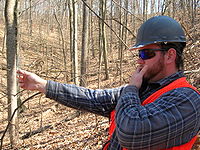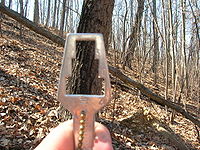
Angle gauge
Encyclopedia


Forest inventory
Forest inventory is the systematic collection of data and forest information for assessment or analysis. It is also commonly known as timber cruising. It is important for owners to cruise the timber to get an estimate of the value and possible uses of the timber...
. Using this tool a forester can quickly measure the trees that are in or out of the plot. An angle gauge is a very similar tool to a wedge prism
Wedge prism
The wedge prism is a prism with a shallow angle between its input and output surfaces. Refraction at the surfaces causes the prism to deflect light by a fixed angle...
though it must be held a fixed distance from your eye for it to work properly. Unlike the wedge prism
Wedge prism
The wedge prism is a prism with a shallow angle between its input and output surfaces. Refraction at the surfaces causes the prism to deflect light by a fixed angle...
, which is held over the plot center, the surveyor's eye is kept over plot center when using an angle gauge.
Using the Angle Gauge
When using an angle gauge the user must count trees that are larger than the width of the angle gauge, as viewed from the center of the plot. The angle gauge is held a set distance away from the eye of the surveyor. Most angle gauges have a string or chain that lets the user know the set distance. Each angle gauge is set at a certain basal area factor, or BAF. Each tree that is in the plot represents this number, the BAF, of square footage. It is multiplied by the number of trees on the plot to give basal area per acre. In the United StatesUnited States
The United States of America is a federal constitutional republic comprising fifty states and a federal district...
BAF is measured in units of square feet. For example, using a BAF 10 angle gauge a forester measures 12 trees that are in trees. Therefore, this plot represents .
Borderline Trees
Some trees are on the borderline of the plot and must be checked to be sure they are to be included. The limiting distance must be calculated to see if the trees are in or out. The equation to calculate the limiting distance in feet is Diameter at breast heightDiameter at breast height
Diameter at breast height, or DBH, is a standard method of expressing the diameter of the trunk or bole of a standing tree. DBH is one of the most common dendrometric measurements....
, DBH, in inches times plot radius factor, PRF, in feet/area Dlim=DBH*PRF
For example, using a BAF 10 angle gauge a forester needs to know the limiting distance for a 20 inches (508 mm) tree. The PRF using a 10 BAF angle gauge is 2.75 foot (0.8382 m) for every inch of tree diameter. Therefore, 20 inches * 2.75 ft/inch = 55 feet (16.8 m). This means that a 20 inches (508 mm) tree must be over 55 feet (16.8 m) away from the center of the plot using a BAF 10 angle gauge to be out of the plot.

